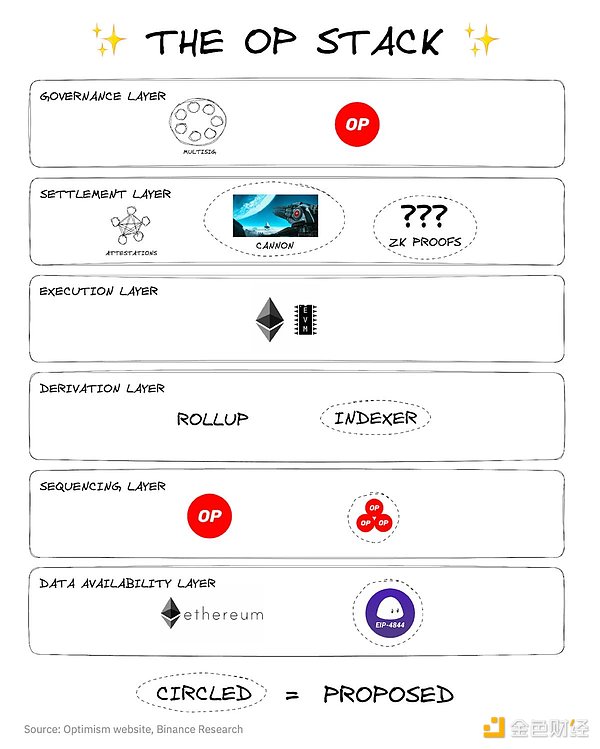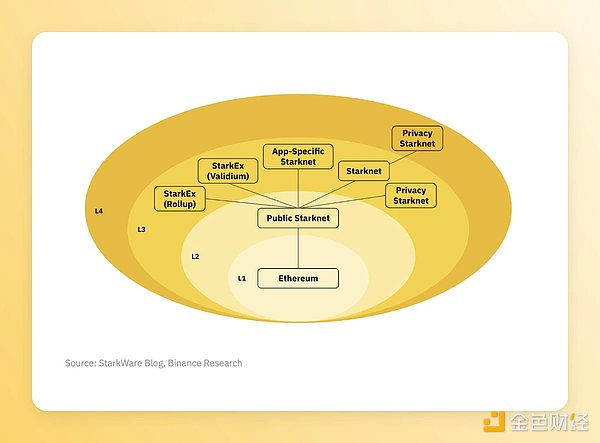Original Author: Stacy Muur Translator: DeepTechFlow
As the L2 war heats up, the future of Ethereum expansion is expected to revolve around L3, SuperChain, and Hyperchain. How to keep up with this trend? Let’s take a deep dive into the forefront of L2 development.

Why has it evolved into this pattern? Although Ethereum operates as L1, it must have the operational capability equivalent to that of the Internet. However, currently, no single L2 has this capability.
- Analysis and Summary of Initial Token Distribution Method for Buidler DAO
- Nostr: Overcoming the digital challenge of social network mapping
- Goodbye Fork Swap, is Uniswap V4 entering the era of “Ten Thousand Hooks”?

From a higher dimension, there are currently three choices for Web3 developers:
• Deploy on Ethereum, but sacrifice scalability.
• Choose an L2 solution, but face the risk of dependency on a specific ecosystem.
• Deploy and maintain your own chain, but may lead to liquidity fragmentation.
In addition, achieving interoperability is also a major challenge. It has been proven that our efforts to address this challenge using cross-chain bridges are fragile and have been continuously attacked by malicious actors. New challenges require innovative solutions. New challenges require innovative solutions.
The next wave of Rollups, such as OP Chains on Optimism, L3 on Arbitrum Orbit, or SuperChains on zkSync, will empower various entities with different goals to create their own customized environments. You can think of it as deploying a new Rollup chain = creating a new web page.
Let us take a closer look at the solutions offered by core expansion participants.
Optimism & OP Stack
In October 2022, Optimism proposed:
• OP Stack – A modular open-source blueprint for creating scalable and interoperable various types of blockchains.
• Superchain – A tightly integrated and unified L2 built on top of OP Stack.
In short, OP Stack can be seen as a “L2 supermarket”. It provides different levels (modules) that can be easily customized to meet the specific needs of a project.
By leveraging this approach, they can unleash the potential of SuperChain in the future.

In early June, Optimism announced that they would be migrating their L2 Rollup to Bedrock. This release represents the first official launch of the OP stack, making the OP mainnet the most cost-effective Ethereum L2 Rollup for token exchange.

In addition, Bedrock has the following advantages:
• Shortened deposit time from 10 minutes to 3 minutes.
• Enhancing proof modularity by supporting fault-proof and ZK proof.
• Allowing multiple transactions to be executed within a single Rollup “block”.
After completing the Bedrock upgrade, Optimism’s next step is to transition to the Superchain.
The Superchain is a decentralized network consisting of L2 (OP chain) that will share security, communication layer, and open-source technology stack (OP stack).

What’s next? The Alpha phase starts here.
• Optimism’s L2 Rollup chain – the first member of the Superchain.
• Coinbase’s upcoming Base L2 – the second member, expected to announce the mainnet launch later this year.
• Worldcoin has also pledged to build on the OP Stack.
• AEVOXYZ, a decentralized options exchange, recently launched a Rollup based on the OP Stack in collaboration with Conduit.
• opBNB on the BNB Chain also leverages the OP Stack.
• Zora Network, developed by OurZORA, is an L2 solution built on the OP Stack.
Arbitrum Orbit
Arbitrum is currently the largest and most advantageous L2 network calculated by TVL (Total Locked Value), with a total value of over $5.9 billion, accounting for more than 60% of the market share.
Arbitrum offers 4 core products:
-
Arbitrum One: This is the first mainnet Rollup of the Arbitrum ecosystem.
-
Arbitrum Nova: An AnyTrust solution designed specifically for cost-sensitive and high-transaction-volume projects.
-
Arbitrum Nitro: This technology software stack powers Arbitrum L2, making Rollup faster, cheaper, and more compatible with the Ethereum Virtual Machine (EVM).
-
Arbitrum Orbit: This development framework allows for the creation and deployment of L3 on the Arbitrum mainnet.
L3 Rollup, also known as application chains, plays a crucial role in settling transactions to the Arbitrum chain. They are the foundation for the next phase of Arbitrum’s expansion journey and are the solution to achieving their vision.
Arbitrum places great emphasis on customizability. Orbit is designed to be compatible with the upcoming Arbitrum Stylus upgrade. This compatibility enables developers to build dApps using C, C++, and Rust, extending Arbitrum’s versatility and coverage.
zkSync & Hyperchain
Now let’s turn to zkSync and its vision for the future of Ethereum scaling.
Hyperchains are zkSync’s vision for L3, conceived as a vast, trustless, and customizable linked blockchain ecosystem.

Simply put, Hyperchains refer to independent ZK chains on Ethereum. These chains are connected to each other through a series of customizable and completely trustless super cross-chain bridge networks. This approach helps overcome vulnerabilities typically associated with non-native bridges.
StarkWare & Fractal Scaling
In theory, the system can have an infinite number of Hyperchains to represent the whole. This is what StarkWare, as a pioneer of Fractal Scaling, needs to do.

In summary, StarkWare’s multi-layer network paper proposes L2 design for general-purpose scaling, while L3 is for customized scaling. However, aside from the initial paper release, StarkWare has made no further announcements.
Polygon 2.0
Polygon recently released an update on the next stage of their L2 development. Polygon 2.0 aims to create the “value layer of the internet.”
The solution aims to improve interoperability between Polygon zkEVM, PoS, and the SuperNet through a series of upgrades. By combining zero-knowledge technology with existing PoS mechanisms, Polygon aims to enhance security and privacy protection.
In Polygon 2.0, their goal is to combine the strengths of both technologies. The Polygon team’s recent announcement revealed their plan to transition Polygon PoS to zkEVM validium by the end of Q1 2024.
Overall, the evolution of Ethereum’s scaling solutions is a topic worth paying close attention to in the coming months, as each L2 giant has presented their own solution, but it is still unknown who will come out on top.
Like what you're reading? Subscribe to our top stories.
We will continue to update Gambling Chain; if you have any questions or suggestions, please contact us!